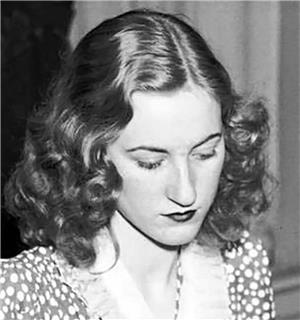On June 21, 1940, Velma Crismon (b. circa 1924), a student at Lincoln High School in Tacoma, types 113 words per minute at the International Typewriting Contest in Chicago, setting a new world record for high school students. She uses an early IBM electric typewriter with a keyboard patented by August Dvorak (1894-1975). A longtime education professor at the University of Washington, Dvorak is an efficiency researcher and has developed the keyboard in response to a request to analyze persistent errors among typing students.
A Competitive Keyboard
American speed typing competitions began in the early twentieth century, serving as promotional opportunities for competing typewriter brands. The first of the Chicago international contests was in 1906. It was won by 17-year-old Rose L. Fritz (1888-1959?), at 82 words per minute, and it made her a trans-Atlantic celebrity. The Prince of Wales, later King George V (1865-1936), asked her to autograph a letter she typed for him. Fast typists with a bit of flair could move beyond secretarial work and newspaper dictation into showmanship -- typing blindfolded, typing without finger protection in freezing weather, typing with mittens in warmer weather, typing on a metal drum to simulate the sound of a speeding train.
Dvorak was an education professor at the University of Washington with an interest in workplace efficiency when he got a request from a typing teacher. She wanted to know why typists tended to misspell a consistent list of short, familiar words. Dvorak used time-and-motion studies to determine that the issue was the placement of letters on the standard QWERTY keyboard. Users had to make unnecessary movements to spell many common words, leading to avoidable errors. He decided to come up with something better. Working with his brother-in-law, William Learned Dealey (1891-1986), he designed and patented a keyboard that grouped the most common letters and letter combinations to streamline finger motion.
The Dvorak Gospel
The University of Washington tried out his method in its typing classes, and Dvorak persuaded the Tacoma School District to teach it to 400 of its junior high students. They learned easily and typed fast. Some alumni of these programs became typing teachers themselves and spread the Dvorak gospel around the region, in turn producing many of the early contest champions.
During the period between 1933, when Dvorak and his disciples began teaching the system in the Pacific Northwest, and 1946, when the official contests ended, converts to the Dvorak keyboard set 26 international records. One reason so many competed was that Dvorak paid for many of their trips as a promotion of his system. "Between 1933 and 1941 he spent most of his university salary and the bulk of two small inheritances, about $40,000 in all, promoting his system" (Morgan, 12).
Speed on the Keys
Eight of the international records were set by Lenore Fenton (1912-2005), a University of Washington graduate from Snohomish. She reached an unofficial 182 words per minute using Dvorak's system. In 1943 she made a series of Navy training films on typing and later wrote an instruction book: Typing Techniques and Shortcuts. She donated her IBM Electromatic typewriter with a Dvorak keyboard to the Smithsonian Institution, where it appeared in a 1992 exhibit and slide show called "The Case Against QWERTY."
Olive Dalin (1917-2006), another Tacoman and Lincoln High School graduate, said the Dvorak keyboard she used at her job with the Bureau of Internal Revenue was almost too fast. "I can't slow down. If I work in a federal office where, say, the quota is 300 forms a day I end up doing a thousand. Then all the other girls are mad at me. So I try to adjust by speed by stopping and fixing my hair, or going out for coffee. Then the boss is mad at me" (Morgan, 3).
Crismon disappeared from public records after her four-trophy outing, perhaps in part because the competitions were suspended during the World War II years.

